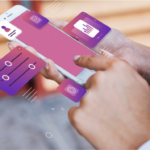In this ever changing world of networking, making connections is like planting seeds for future opportunities. And when it comes to exchanging contact info, there’s a lively debate between the good old paper business cards and their digital cousins. Let’s understand the mystery and explore why some folks still swear by paper while others are all about going digital.
But before that, let’s understand what digital business cards are? Digital cards are just business cards, but they’re available digitally. They’re in your phone, not in your pockets. They’re a click away, not a distance away. Yes, these digital business cards do exist and they’re getting popular as the days go by.
Confused which one to use? This is why this blog exists! Let’s have a healthy debate about which out of the two is better and why! It’s important to also discuss the future of the two. Which one will stay alive for a long time, beating all the odds, which one will just fizzle after a short while, and which will take over.
The Charm of Traditional Paper Business Cards
Imagine that you’re at a networking event, and someone hands you their paper business card. It’s tangible, it’s real, and oh! the smell of paper! There’s a certain charm to it. We’ve almost grown up with paper cards, we’ve seen them everywhere, which is why they’ll always hold a special place in our hearts. Here’s why paper cards still hold a concrete place when it comes to networking:
1. Nostalgia and Tangibility: Holding a paper card feels different. It’s like holding a piece of someone’s story. There’s a nostalgic charm to flipping through a collection of cards you’ve gathered over time. It also feels all the more real.
2. Personal Touch: Handing over a paper card creates a moment. It’s a chance to make eye contact, exchange smiles, and maybe even strike up a conversation. It’s more personal than just tapping phones together.
3. Showcasing Style: With paper cards, you can get creative! From sleek minimalist designs to bold colours and textures, your card can reflect your personality and style. The same goes for digital cards as well. However, eye-catching designs on paper hits different.
But Wait, There’s More: The Ups and Downs of Paper
Of course, paper cards aren’t without their quirks and even their cons.
1. Limited Space: There’s only so much you can fit on a tiny piece of paper. Your card might have your name, title, and contact info, but what about your LinkedIn or Instagram? Paper cards can feel a bit cramped or clustered.
2. Risk of Misplacement: Ever lost a business card in the depths of your bag or pocket? It’s like a game of hide-and-seek. Paper cards can easily get lost or damaged, leading to missed connections.
3. Eco-Conscious Dilemma: In today’s eco-aware world, using paper cards raises eyebrows. They’re not exactly tree-friendly, and the printing process can be a bit of a carbon footprint culprit. With enough awareness today, people have understood the importance of being eco friendly and seem to be embracing it well. Pandemic was a major wake up call as well.
Enter the Digital Era: Digital Business Cards
Now, imagine a world where your entire contact info fits well in your pocket – no paper cuts, no fuss. Enter digital business cards, the modern means of networking.
1. Instant Accessibility: With digital cards, sharing info is as easy as a swipe or a tap. No more fumbling for cards in your wallet or purse. Just whip out your phone and voilà – instant connection!
2. Multimedia Magic: Say goodbye to plain text – digital cards let you spice things up! Add links to your website, portfolio, or social media. You can even throw in a GIF or two for good measure.
3. Mother Earth Approved: Green is the new black, and digital cards are leading the charge. No trees harmed, no ink spilled, and most importantly, no raised eyebrows – just pure, eco-friendly networking at its finest.
But Beware
But of course, digital cards aren’t flawless either. Everything comes with its cons and digital cards are no different.
1. Tech Hiccups: What happens when your phone dies or your internet stops working? Suddenly, that fancy digital card isn’t looking so reliable. Digital cards rely on tech, and tech can be temperamental.
2. Less Face Time: Swapping digital cards lacks the personal touch of exchanging paper ones. It’s quick and convenient, sure, but it’s missing that human connection – the warmth of a handshake, the sparkle in someone’s eye.
3. Privacy: With digital comes the risk of data breaches and privacy concerns. Sharing your digital card means sharing your digital footprint – and not everyone’s comfortable with that.
So, What’s The Verdict?
In the timeless showdown between paper and digital, there’s no clear winner. It all boils down to personal preference and circumstance.
Love the nostalgia and personal touch of paper? Stick with traditional cards. Prefer the convenience and eco-friendliness of digital? Go digital, my friend. And hey, why not dabble in both? Keep a stash of paper cards for those special moments and have your digital card ready for everyday networking.
At the end of the day, whether you’re swapping paper or digital, the goal remains the same: making connections, building relationships, and growing together. So, go forth, network ninjas, and may your cards – paper or digital – lead you to new horizons!
However, as the world is becoming more tech friendly and embracing quick, fast technologies. Naturally, we will change with time as well. A year ago, Chat GPT did not exist, but today we can’t imagine our lives without it.
Decades ago, cars or bikes didn’t exist. People went about their ways by bicycle or by walking. Today, bicycles and walking are performed mainly for exercise, while cars and bikes are the primary mode of transport. We never thought schools would be online, or we’ll have to stay at home and the internet will save us all, but it happened and we adapted to the change. So, as time progresses and our society becomes more technologically advanced, digital cards can get popular, making networking as easy as possible.
In 2023, the global digital business card market soared to an impressive US$ 163.5 Billion. Brace yourselves for what’s ahead because IMARC Group anticipates a bigger surge, projecting the market to reach a staggering US$ 360.4 Billion by 2032. Get ready to witness an electrifying journey with a projected growth rate (CAGR) of 9.18% from 2024 to 2032. The future of networking is vibrant, exciting and full of new opportunities.
Both means of networking, paper card and digital card can co-exist, without one ruling out the other. But in a technologically advanced society, it is important to understand about the new trend rather than sticking to old ones, though they are perfect. It just leaves us with more options, and we can get creative with it. We may use both types of cards depending on the situation, and make the best of both worlds.
Conclusion
Hopefully, you’ll now have understood well about both, paper cards and digital cards. We looked in depth about each other’s pros and cons and ended this ongoing debate once and for all. The answer we received was that both types of cards are equally important but we are adaptable beings. It will take a while but if the world is to become completely digital, (Lockdown! Doesn’t that ring a bell?) we will adapt to digital cards in no time.
It’s true that digital cards are already catching fire. So, do you wish to make one or explore the world of digital cards? Digitize Cards are here to wave their magic wand and give you the best means possible. Create digital business cards with exciting templates, creative content and you’re sure to make a lasting impression. They are also known as visiting cards and we help you to create visiting card online!Go ahead, create virtual business card of your own with Digitize cards and network away!
As we look towards the future, it’s clear that networking will continue to evolve, driven by emerging technologies and shifting societal norms. Whether we’re exchanging paper cards at a conference or seamlessly sharing digital contact information with a swipe of our phones, the essence of networking remains unchanged: it’s about forging genuine connections, nurturing relationships, and seizing opportunities for growth.
So, let’s embrace the duality of paper and digital, knowing that each has its own unique role to play in our networking endeavours. Let’s celebrate the versatility and adaptability of human ingenuity, confident in our ability to navigate the ever-changing landscape of connectivity.
As we embark on this journey of networking, armed with both paper and digital cards, let’s remember that ultimately, it’s not the medium that matters, but the connections we forge and the relationships we cultivate along the way. Here’s to a future of boundless possibilities, where networking knows no bounds and innovation knows no limits.



